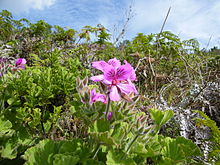Pelargonium
| Pelargonium | |
|---|---|
 |
|
| Pelargonium cucullatum | |
| Scientific classification | |
| Kingdom: | Plantae |
| (unranked): | Angiosperms |
| (unranked): | Eudicots |
| (unranked): | Rosids |
| Order: | Geraniales |
| Family: | Geraniaceae |
| Genus: |
Pelargonium L'Hér. |
| Type species | |
|
Pelargonium hirsutum (Burm. f.) Sol. ex Aiton |
|
| Subgenera | |
|
|
| Diversity | |
| At least 200 species | |
Pelargonium cucullatum
(L.) W. Aiton
Pelargonium /ˌpɛlɑːrˈɡoʊniəm/ is a genus of flowering plants which includes about 200 species of perennials, succulents, and shrubs, commonly known as geraniums (in the United States also storksbills). Confusingly, Geranium is the botanical name (and also common name) of a separate genus of related plants often called cranesbills. Both genera belong to the family Geraniaceae. Linnaeus originally included all the species in one genus, Geranium, and they were later separated into two genera by Charles L’Héritier in 1789.
Pelargonium species are evergreen perennials indigenous to temperate and tropical regions of the world, with many species in southern Africa. They are drought and heat tolerant, but can tolerate only minor frosts. Some species are extremely popular garden plants, grown as bedding plants in temperate regions.
Pelargonium occurs in a large number of growth forms, including herbaceous annuals, shrubs, subshrubs, stem succulents and geophytes. The erect stems bear five-petaled flowers in umbel-like clusters, which are occasionally branched. Because not all flowers appear simultaneously but open from the centre outwards, this is a form of inflorescence is referred to as pseudoumbels. The flower has a single symmetry plane (zygomorphic), which distinguishes it from the Geranium flower, which has radial symmetry (actinomorphic). Thus the lower three (anterior) petals are differentiated from the upper two (posterior) petals. The posterior sepal is fused with the pedicel to form a hypanthium (nectary tube). The nectary tube varies from only a few millimeters, up to several centimeters, and is an important floral characteristic in morphological classification. Stamens vary from 2 to 7, and their number, position relative to staminodes, and curvature are used to identify individual species. There are five stigmata in the style. For the considerable diversity in flower morphology, see figure 1 of Röschenbleck et al. (2014)
...
Wikipedia
